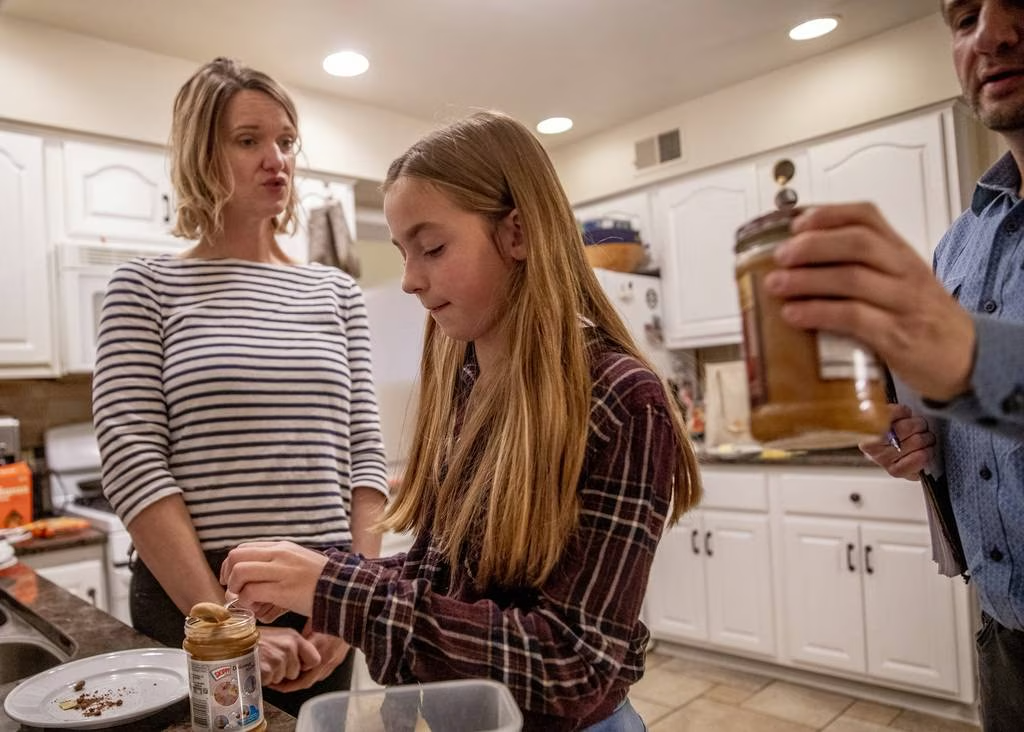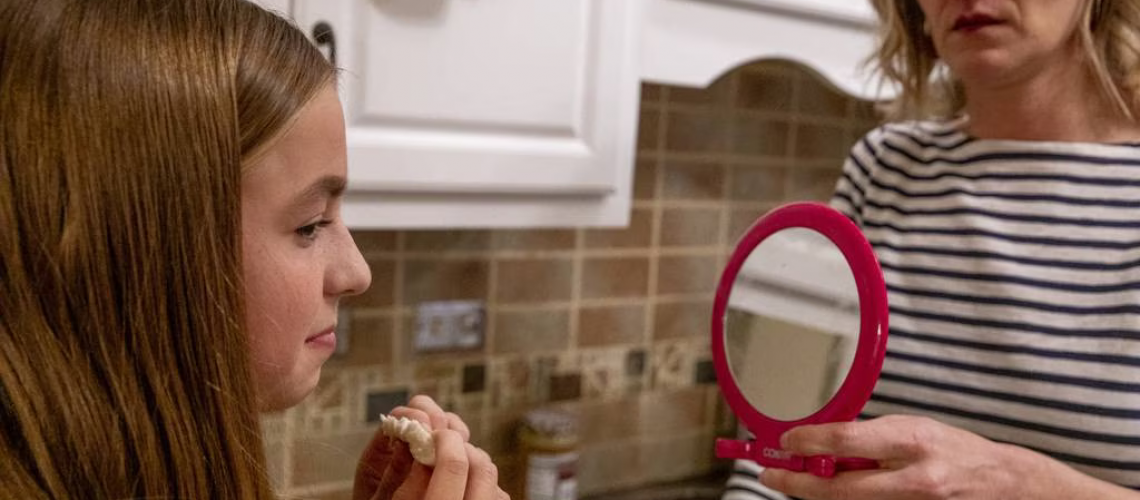For those of us working with children every week, pediatric feeding therapy is an essential given. But we also find that many parents—and even some social services & medical providers—don’t even know that specialists like us are an option.
Which is why when Get Permission Institute co-founder Karen Dilfer, OTR/L, MS, treated a 12-year old girl with picky eating using the Get Permission Approach with huge success, her Chicago Tribune columnist father wanted to write about it.


By Josh Schonwald
Published: Feb 07, 2020
The breakthrough bite took place about 30 minutes into treatment. My daughter Kate bravely raised a cracker to her mouth and, with little hesitation, took a bite. That cracker had cinnamon in it, a spice she hadn’t tried in years.
Most parents have struggled with picky eating children. But Kate, my funny, ordinarily easygoing 12-year-old daughter, is an extremely picky eater.
She has never met a fruit she likes. She won’t sit next to someone eating bananas, blueberries or yogurt. And she’s so choosy about breakfast and lunch foods that for the past four years, she’s been drinking Ensure, a nutritional supplement, for those meals.
That’s what led us to seek the aid of Karen Dilfer, a Chicago-based occupational therapist who specializes in food therapy. There are many pediatric food therapists in the area who cover a wide range of issues — from infants struggling to swallow food, to preschoolers with sensory processing challenges, to teens with food-related anxieties — but Dilfer was one of a smaller subgroup of therapists who worked with kids similar to Kate: 7 to 18, often bright, well-adjusted, with no other special needs or medical issues.
Also, Dilfer comes directly to your home. Jennifer Dean, a Northbrook mom of an extremely selective eater, told me therapy with Dilfer has been transformative. Her son, Quinn, started with only 10 foods on his list, now has 20, and recently had a breakthrough. “He ate a ham and cheese sandwich at Subway,” she said. “I was like, thank you, Lord.”
I, too, longed to hear Kate call me from Subway rapturous about trying a new sub. Last month, we tried food therapy: an evaluation and in-home treatment.
Kate isn’t eating mango quinoa salads just yet, but food therapy, even two sessions, was a great step for our family — and for reasons we never expected. Here are our most valuable takeaways:
Changes attitudes about picky eating
Instead of focusing on what Kate didn’t eat, Dilfer sought to understand why Kate has certain taste preferences, and then go from there. It was a glass-half-full view of picky eating.
Dilfer started with lots of questions — about goals, challenges, Kate’s likes, dislikes, former likes, turning points, hardships, even our family food history. Another Chicago food therapist, Lindsey Lieberman, described this part of her role as “food detective.”
Dilfer’s questioning helped develop her treatment strategy, but it also gave us more insight into Kate’s pickiness. After sharing some details from Kate’s history with fruit, Dilfer observed that she likely has a hypersensitive sense of smell, which could be a reason for some of her aversions. Her dislike of fruits is also consistent with her taste profile: She favors “savory over sweet.” Most liberating, though, was Dilfer’s message on fruit. In a culture focused on healthy eating, a diet without fruit has been a source of pressure and shame for Kate and us. “You don’t have to eat fruit,” she said, noting that Kate can get essential vitamins in other foods.
When I confessed, almost shamefully, the details of my kid’s diet — pasta with cheese, pizza, hamburgers, Cheez-Its — Dilfer put a positive spin on it. Kate liked savory, had a protein-heavy diet, and was comfortable eating at restaurants. Even Kate’s ramen habit had an upside: “Noodles are a food group.”
The value of this positive attitude readjustment soon became clear. Our goal was to start in Kate’s food comfort zone, and then use a technique called “stretches,” so she could have positive experiences with new foods. By the end of our session, she had my wife and me excitedly brainstorming stretches with her: Ramen could be a gateway to udon or soba noodles; Kate’s love of cheese could be a motivator for exploration. Dilfer also injected a level of mind-expanding flexibility. “Ramen and salami for breakfast?” I asked. “Absolutely,” Dilfer said.
Empowers a picky eater
Of all of her experiences with food, Kate says the worst happened at camp. Extra-anxious, away from home, surrounded by cabin mates at breakfast, her counselor pushed her to clean her plate and eat “more than bread.” She was shamed and embarrassed.
Dilfer made it clear that “clean your plate” should never happen in our house. And after meeting one-on-one with Kate, she presented us with a six-point list titled “Food Guidelines” and posted it on our refrigerator.
Kate, who created the “Food Guidelines” with Dilfer, pointed to No. 2 on the list: “No one can make you eat a new/different food.” The new guidelines gave Kate precisely what she wanted — she could refuse food and never had to eat more than she wanted.
Decades of research on children and feeding has found that pressuring children to “clean the plate” is bad for kids. Dilfer, who trained with Marsha Dunn Klein, a renowned food therapist and author of “Anxious Eaters, Anxious Mealtimes,” uses an approach that focuses on reducing anxiety around mealtimes by building trusting relationships and making mealtime a “safe place.”
Kate’s newfound power also came with new roles. Under the new order, she would play a bigger role in shopping, preparing and serving food. Even if she didn’t like a food, Dilfer encouraged us to give her a role, such as serving the salad. “Seeing other people enjoy the salad, even if she doesn’t like it,” Dilfer said, “that is a positive model for her.”
At the end of her first treatment, Kate got a chance to cook whatever she wanted. She made pizza and mushrooms in a toaster oven.
Dilfer demonstrated a method she called “redefine try it” on one of Kate’s biggest needs: breakfast foods. The method looked, at first, like a lab examination of a cracker. Dilfer guided Kate through several steps — she looked, touched, smelled and listened to the sound of the cracker. After each step, Kate was asked to describe what she thought the cracker would taste like.
It wasn’t until going through the pretasting process, gaining comfort and confidence at each step, that Kate actually tasted a cracker crumb. Although tasting just a crumb struck Kate as comical, that method has extraordinary success in palate changing, according to research.
After the crumb, Kate took a “mousebite,” and decided she didn’t like the cinnamon cracker. “If she says no to a food,” Dilfer said, “that’s fine. That’s her right. That cannot be the end of the story. You have to say, it’s OK, and keep presenting her with new options. That’s the art.”
The therapist recommends trying a combination method too. It’s pairing a new food with a liked, familiar flavor, using dips and spreads. When Kate found a chocolate cracker that she was just OK with, Dilfer encouraged her to try spreads. Hazelnut? Butter? Peanut butter? She kept saying “no.” Dilfer kept brainstorming. Finally, they stumbled on an approved option: chocolate and peanut butter on saltine crackers.
Dilfer’s final report gave us exactly what we wanted: ideas for foods that appealed to Kate’s tastes and responded to our worries about breakfast and lunch. It felt like the days of bulk shipments of chocolate Ensure were numbered.
Her diet won’t completely change overnight, and it will require energy and patience, but Dilfer’s visit affected us more than expected. Learning more about Kate’s perspective, and thinking differently about our role in feeding her has already made us more thoughtful, creative and relaxed about food.
https://www.chicagotribune.com/lifestyles/sc-fam-kids-picky-eaters-0211-20200207-3za6wjdl6vcuhequgorzztevu4-story.html



